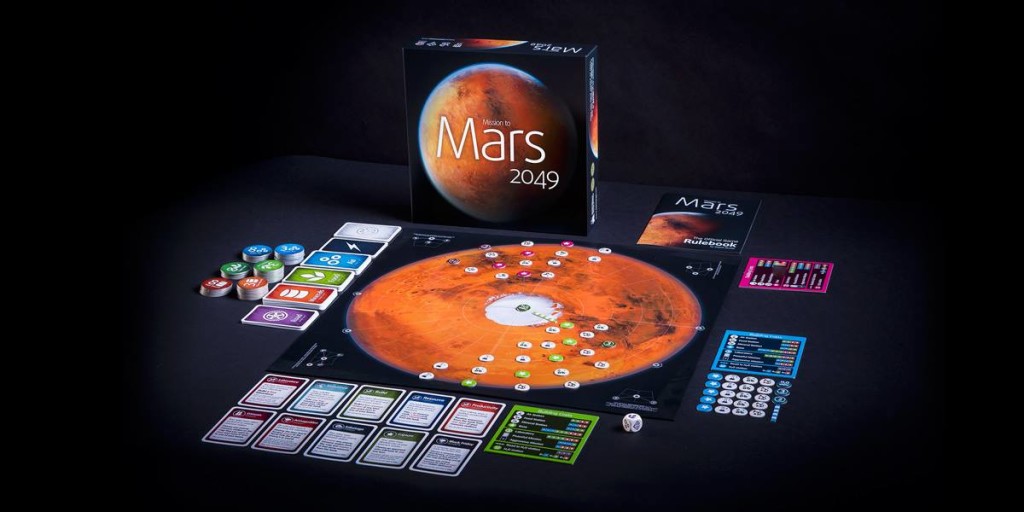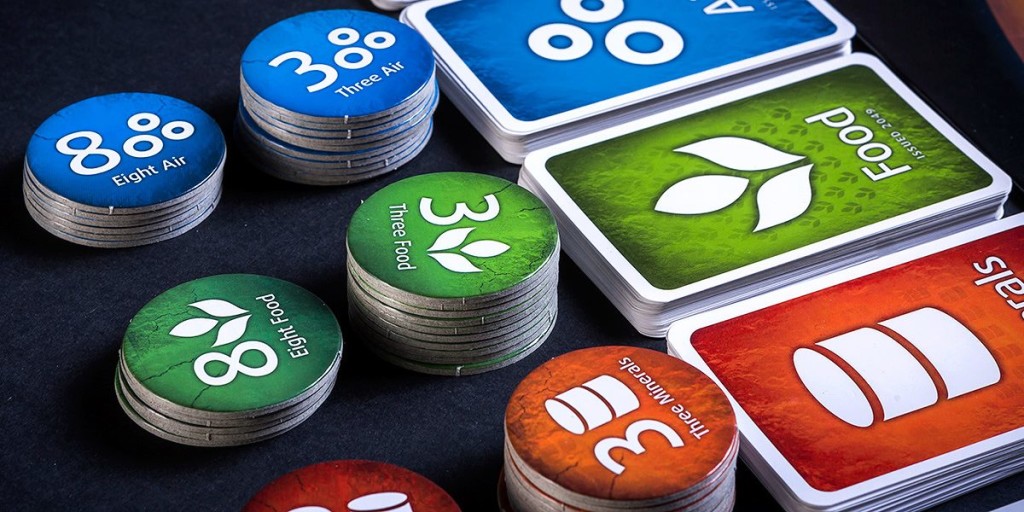Mars seems to be all the rage these days (and it’s about time). This might be my inner-geek talking, but space exploration and awareness seem to have taken a back seat as of late, at least here in the US. That’s a real shame, mainly because there’s so much out there that we haven’t discovered yet. “Mission to Mars 2049” doesn’t exactly get us on a shuttle to outer space, but it does envision a day where man begins to colonize Mars. Of course, they’ll need a steady supply of water, which is where the North Pole comes in. Here, players will be racing to the get to the North Pole first by building structures and managing resources. Before we begin, I’d like to thank Designer and CEO Dagnis Skurbe for reaching out and providing a press copy for review purposes.

Mission to Mars 2049: 2-4 Players, Ages 9+, Average Play Time = 45-90 Minutes
Components
The includes a game board, building tokens (bases, resources stations, laboratories, roads, & H2O stations), cards & resources (resource cards, resource tokens, road cards, & mission cards), one game die with different symbols on it, and a rulebook.
Setup & Gameplay
Each player starts with one base on the very edge of the planet in such a way to where they’d be as far apart as possible. Next, each player places one of each resource stations (air, food, & mineral) next to their base. They also get two of each resource card. A die roll determines who goes first.
At the beginning of a player’s turn, they’ll roll the die. If one of the three resources comes up (air, food, or minerals), then everyone receives its matching resource card. Other symbols allow you to steal cards (not tokens) from other players, receive a resource of your choice, or simply skip your turn.
After rolling the die, they can trade resources to the bank, exchange resource cards for tokens (tokens represent multiple cards), build structures/bases, and buy & play one mission card. All structures must be placed next to a base, so be sure to leave room for a new base so that you can progress towards the center. There’s no limit to how many structures you can build on a turn, so as long as you have the resources to do so.
To win the game, a player must be the first to build at least five bases, a polar road leading to the north pole (via three road cards), and finally the water extraction site itself.
Editor’s Note: The above doesn’t cover all of the rules found in the manual, but should give you an idea as to how the game is played.

The Review
Folks who have played “Settlers of Catan” will probably experience some Déjà vu right out of the gate, which isn’t necessarily a bad thing. For starters, players roll a die at the beginning of their turn and there’s a chance that everyone collects resources. In addition, players are building paths around the board consisting of various structures and you can even build trade depots to make the 4:1 resource trade ratio to the bank a bit cheaper…sound familiar? The rules between both games aren’t identical mind you, but anyone who’s played “Settlers of Catan” before will be able to learn the rules in almost no time at all.
With that said, there are some differences that set the game apart from “Settlers of Catan”. For example, I like the fact that you can exchange resource cards for tokens which are protected from robbery. The mission cards are pretty neat as well, coming in both a passive and aggressive deck. The passive cards, for the most part, offer resources and protection while the aggressive cards attack other players by stealing resources and blowing things up. If you go this route you’ll need to be careful, as some cards target the leader…even if that’s you!
The price per the official website as of 3/2/16 is € 39.95, which equates to roughly $43…a little pricey for a relatively simple game, I’ll admit. Why this game and “Settlers of Catan” retail for over $40 is beyond me. Yes, the components of this game are of good quality so that may have something to do with it, though penny-pinchers like myself may pass this up in favor of other Euro games that are less expensive and offer more bang for your buck. With that said, I very much enjoyed playing this game…probably because the rules and gameplay mechanics closely resemble the aforementioned “Settlers of Catan” (I prefer the Star Trek version, myself).
All things considered, “Mission to Mars 2049” is most definitely a keeper. It utilizes mechanics that make “Settlers of Catan” so popular, but offers a few twists that keeps things new and fresh. The “Did You Know” section toward the back of the manual, which is beautifully colored and laid out by the way, is a nice touch. Anyone who enjoys playing “Settlers of Catan” should probably take a look at this title, at the very least.
Final Verdict: 8/10
—
